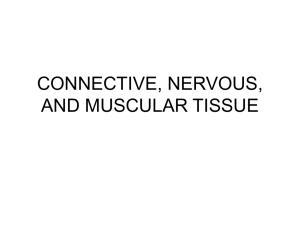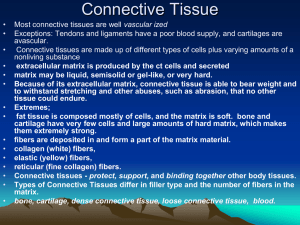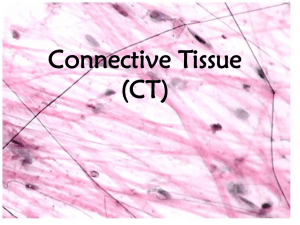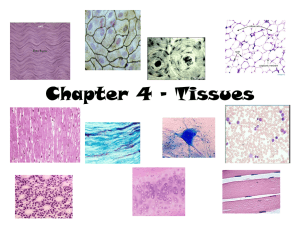Connective Tissue Powerpoint
advertisement
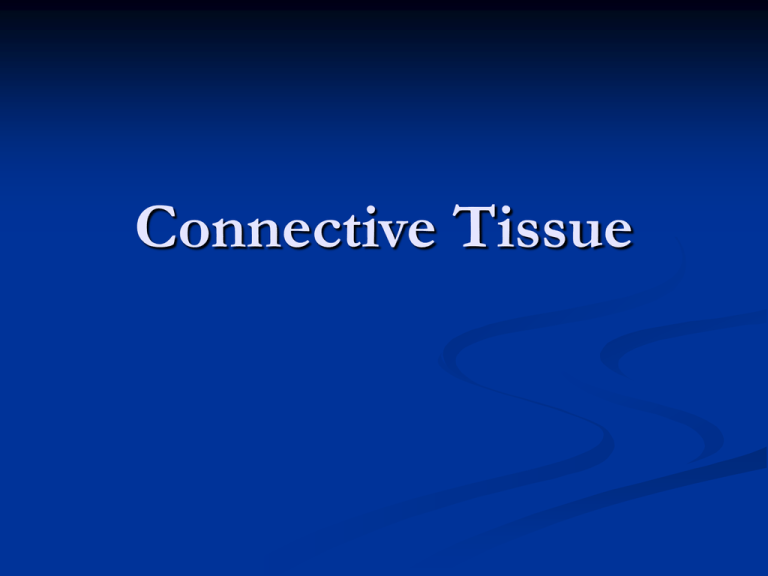
Connective Tissue Connective Tissue Binds together, supports and strengthens other body tissues Protects and insulates internal organs Compartmentalizes structures such as skeletal muscle The major transport system within the body Site of stored energy reserves Main site of immune responses General Features of Connective Tissue 2 basic parts: Cells and Matrix Matrix – material between widely spaced cells Consists of protein fibers and ground substance Ground substance – material between cells and fibers secreted by the cells and determine the tissue qualities General Features of Connective Tissue Does not occur on free surfaces Has a nerve supply (except cartilage) Highly Vascular (except cartilage and tendons) Connective Tissue Cells Fibroblasts – large flat cells with branching processes. Migrate throughout connective tissue secreting the fibers and ground substance Macrophages – develop from white blood cells. Surround and engulf material by phagocytosis Mast Cells – alongside blood vessels that supply connective tissue. Produce histamine – a chemical that dilates blood vessels. Adipocytes – “fat cells” store triglycerides. Connective Tissue Matrix – Ground Substance Ground Substance – component of a connective tissue between the cells and fibers, supports cells, binds them together, and provides a medium through which substances are exchanged. Ex. Hyaluronic Acid Connective Tissue Matrix – Fibers Strengthens and supports connective tissue Collagen Fibers Strong, resist pulling forces, flexible Made of the protein collagen which is the most abundant protein in your body Elastic Fibers smaller in diameter than collagen fibers, branch to form network Made of the protein elastin Reticular Fibers Provide support for the walls of blood vessels Made of collagen with a glycoprotein covering Marfan Syndrome An inherited disorder caused by a defective gene for the glycoprotein fibrillin resulting in abnormal development of elastic fibers. This causes tissues that contain many elastic fibers to be malformed or weak (including the covering of bone, ligament that suspends the lens of the eye, and the walls of large arteries People with Marfan syndrome are often tall, have long arms, legs, fingers and toes, blurred vision, and weakened aortic walls that may burst. Types of Connective Tissue There are 6 types of connective tissue that vary by the fibers, ground substance and cells contained in it. Each type has a very specific structure and function. Loose Connective Tissue Fibers are loosely intertwined among many cells. 3 types of loose connective tissue Areolar Connective Tissue – one of the most widely distributed connective tissues in the body. Contains fibroblasts, macrophages, plasma cells, mast cells, adipocytes and a few white blood cells as well as all 3 types of fibers Helps to form the subcutaneous layer Loose Connective Tissue Adipose Tissue – The cells, called adipocytes, are specialized for storage of triglycerides. Adipocytes fill up with a large fat droplet so the nucleus gets pushed to one side of the cell. Used for insulation, protection and as an energy reserve Reticular Connective Tissue – made of interlacing reticular fibers and reticular cells that connect to each other to form a network. Used to bind together smooth muscle cells and to filter out worn out blood cells and bacteria Dense Connective Tissue Contains more numerous, thicker and denser fibers but fewer cells than loose connective tissue. 3 types: Dense regular connective tissue Dense Irregular connective tissue Elastic Connective Tissue Dense Regular Connective Tissue Bundles of collagen fibers are arranged regularly in parallel patterns that give it strength. Withstands pulling from the ends, but unravels when pulled from the side Silvery white in appearance. Tough and pliable Found in tendons and ligaments Dense Irregular Connective Tissue Collagen fibers are packed closely together in an irregular, random pattern Found in parts of the body where pulling forces are exerted in various directions Usually found in sheets Examples: Dermis of the skin, heart valves, perichondrium and periosteum Elastic Connective Tissue Contains branching elastic fibers and fibroblasts Yellowish in color Strong, can regain shape after stretching Found in lungs and arteries Cartilage Dense network of collagen fibers and elastic fibers embedded in chondroitin sulfate (a rubbery component of the ground substance) Can withstand more stress than the dense and loose connective tissue. Collagen fibers make the tissue strong, chondroitin sulfate makes it resilient Cartilage - continued Chondrocytes – mature cartilage cells Lacunae – holes in the matrix in which the cells sit Perichondrium – dense irregular connective tissue that surrounds cartilage 3 types – hyaline, fibrocartilage and elastic Cartilage is AVASCULAR and NO nerve supply (but the perichondrium does) Hyaline Cartilage Gel like ground substance, collagen fibers (not visible with normal stains) and prominent chondrocytes Most abundant cartilage in the body Found at the end of long bones to cushion joints and at epiphyseal plates (growth plates in bones) Weakest of the 3 types of cartilage Fibrocartilage Chondrocytes scattered among visible bundles of collagen fibers No perichondrium Strongest of the 3 types of cartilage Found in the intervertebral discs Elastic Cartilage Chondrocytes located in a threadlike network of elastic fibers Provides strength, elasticity and maintains the shape of certain structures (like the external ear) Bone Tissue (osseous tissue) 2 types – compact and spongy Compact Osteon – basic unit of compact bone Lamellae – concentric circles of matrix Lacunae – spaces in the matrix that house cells Osteocytes – mature bone cells Spongy Trabeculae – columns of bone with spaces filled with red bone marrow Micrograph of Spongy Bone An electron micrograph scan of spongy bone in an osteoporosis patient. Osteoporosis occurs when a body's blood calcium level is low and calcium from bones is dissolved into the blood to maintain a proper balance. Blood Tissue Connective Tissue with a liquid matrix Red Blood Cells (erythrocytes) – transport oxygen White Blood Cells – function in immunity Neutrophils, Eosinophils, Basophils, T and B leukocytes, natural killer cells and Monocytes Platelets – participate in blood clotting




